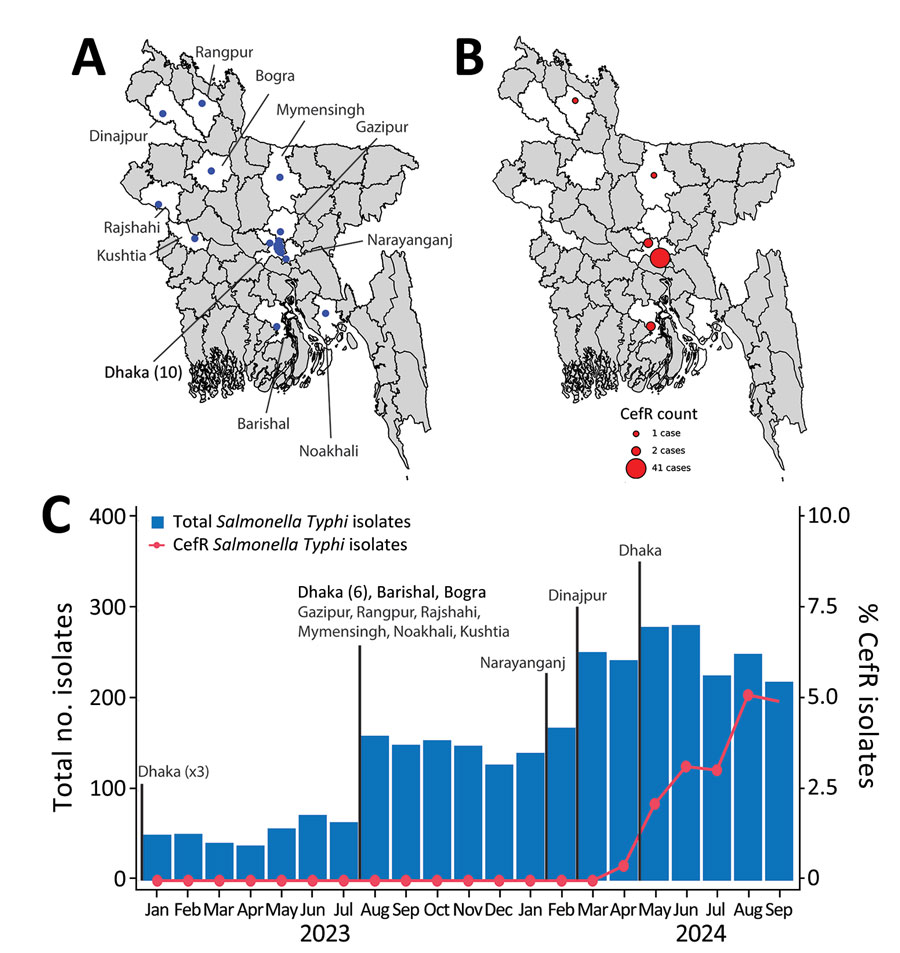Outbreak of Ceftriaxone-Resistant Salmonella enterica Serovar Typhi, Bangladesh, 2024
Yogesh Hooda, Arif Mohammad Tanmoy, Sudipta Deb Nath, Anannya Barman Jui, Al Amin, Hafizur Rahman, Neoyman Nasir Shorkar, Naito Kanon, Md Asadur Rahman, Denise O. Garrett, Mohammad Shahidul Islam, Nawshad Uddin Ahmed ASM, Samir K. Saha, and Senjuti Saha

Author affiliation: Child Health Research Foundation, Dhaka, Bangladesh (Y. Hooda, A.M. Tanmoy, S.D. Nath, A.B. Jui, A. Amin, H. Rahman, N.N. Shorkar, N. Kanon, M.S. Islam, A.N.U. Ahmed, S.K. Saha, S. Saha); Popular Diagnostic Centre Limited, Dhaka (M.A. Rahman); Sabin Vaccine Institute, Washington, DC, USA (D.O. Garrett); Bangladesh Shishu Hospital and Institute, Dhaka (S.K. Saha)
Main Article
Figure 1

Figure 1. Overview of study of an outbreak of ceftriaxone-resistant Salmonella enterica serovar Typhi in Bangladesh, 2024. A) Locations of the 20 study clinics across 11 districts of Bangladesh (blue dots). White indicates districts where the study clinics are located; gray indicates districts not included in this study. B) Geographic distribution of CefR Salmonella Typhi isolates across Bangladesh. The size of each red dot represents the number of isolates per district. C) Timeline of the surveillance network, showing the inclusion of clinics (text labels) and the total number of Salmonella Typhi isolates and CefR isolates detected. Our surveillance efforts began in January 2023 with 3 clinics in Dhaka; more clinics in various locations across Bangladesh were added through May 2024. CefR, ceftriaxone-resistant.
Main Article
Page created: June 02, 2025
Page updated: June 25, 2025
Page reviewed: June 25, 2025
The conclusions, findings, and opinions expressed by authors contributing to this journal do not necessarily reflect the official position of the U.S. Department of Health and Human Services, the Public Health Service, the Centers for Disease Control and Prevention, or the authors' affiliated institutions. Use of trade names is for identification only and does not imply endorsement by any of the groups named above.
